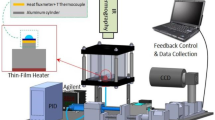Abstract
We carry out combined experimental and theoretical studies of liquid droplet evaporation on heated surfaces in a closed container filled with saturated vapor. The droplets are deposited on an electrically heated thin stainless steel foil. The evolution of droplet shapes is studied by optical methods simultaneously with high-resolution foil temperature measurements using thermochromic liquid crystals. A mathematical model is developed based on the assumptions that the droplet surface has uniform mean curvature and the contact line is pinned during evaporation. Both the dynamics of liquid–vapor interface and the temperature profiles at the foil are shown to be in good agreement with the experimental data.












Similar content being viewed by others
Abbreviations
- c :
-
heat capacity, J/kg K
- d :
-
thickness of the foil, μm
- h :
-
nondimensional droplet height
- h d :
-
droplet height, m
- K :
-
kinetic parameter
- k :
-
thermal conductivity, W/m K
- Δh lv :
-
latent heat, J/kg
- n :
-
nondimensional coordinate
- q :
-
nondimensional heat source term
- R :
-
gas constant per unit mass, J/kg K
- R d :
-
droplet radius, m
- r :
-
nondimensional radial coordinate
- T :
-
nondimensional temperature
- T s :
-
saturation temperature, °C
- T*:
-
temperature, °C
- ΔT*:
-
maximum temperature difference in the system, °C
- t :
-
nondimensional time
- t*:
-
time, s
- V :
-
droplet volume, m³
- z :
-
nondimensional coordinate
- α :
-
nondimensional thermal diffusivity
- ε :
-
ratio of foil thickness and initial droplet radius
- ρ:
-
density, kg/m3
- d:
-
droplet
- f:
-
foil
- s:
-
saturation
- v:
-
vapor
References
Ajaev VS (2005) Spreading of thin volatile liquid droplets on uniformly heated surfaces. J Fluid Mech 528:279–296
Anderson DM, Davis SH (1995) Spreading of volatile liquid droplets on heated surfaces. Phys Fluids 7:248–265
Bai Q, Fujita Y (1999) Numerical simulation of the growth for a single bubble in nucleate boiling. Therm Sci Eng 7:45–53
Deegan RD, Dupont TF, Huber G, Nagel SR, Witten TA (2000) Contact line deposits in an evaporating drop. Phys Rev E 62:756–765
Gokhale SJ, Plawsky JL, Wayner PC (2003) Experimental investigation of contact angle, curvature, and contact line motion in dropwise condensation and evaporation. J Colloid Interface Sci 259:354–366
Höhmann C (2004) Temperaturmessverfahren zur räumlich hochauflösenden Untersuchung des Wärmetransports an einem verdampfenden Flüssigkeitsmeniskus. PhD Thesis, Darmstadt University of Technology, Darmstadt
Hu H, Larson RG (2002) Evaporation of a sessile droplet on a substrate. J Phys Chem B 106:1334–1344
Hu H, Larson RG (2005) Analysis of microfluid flow in an evaporating sessile droplet. Lagmuir 21:3963–3971
Kern J, Stephan P (2003) Theoretical model for nucleate boiling heat and mass transfer of binary mixtures. Trans ASME, J Heat Transf 125:1106–1115
Potash M, Wayner PC (1972) Evaporation from a two-dimensional extended menisci. Int J Heat Mass Transf 42:1851–1863
Mollaret R, Sefiane K, Christy JRE, Veyret D (2004) Experimental and numerical investigation of the evaporation into air of a drop on a heated surface. Chem Eng Res Design 82(A4):471–480
Moosman S, Homsy GM (1980) Evaporating menisci of wetting fluids. J Colloid Interface Sci 73:212–223
Raad T, Myer JE (1971) Nucleation studies in pool boiling on thin plates using liquid crystals. AIChE 17:1260–1261
Rose J (2000) Accurate approximate equations for intensive sub-sonic evaporation. Int J Heat Mass Transfer 43:3869–3875
Schrage RW (1953) A theoretical study of interphase mass transfer. Columbia University Press, New York
Stasiek J, Collins M (1996) The use of liquid crystals and true color image processing in heat and fluid flow experiments. Atlas Visual 2:79–104
Stephan P, Brandt C (2004) Advanced capillary structures for high performance heat pipes. J Heat Transfer Eng 25:78–85
Stephan P, Busse CA (1992) Analysis of the Heat Transfer Coefficient of Grooved Heat Pipe Evaporator Walls. Int J Heat Mass Transfer 35(2):383–391
Author information
Authors and Affiliations
Corresponding author
Rights and permissions
About this article
Cite this article
Sodtke, C., Ajaev, V.S. & Stephan, P. Evaporation of thin liquid droplets on heated surfaces. Heat Mass Transfer 43, 649–657 (2007). https://doi.org/10.1007/s00231-006-0126-6
Received:
Accepted:
Published:
Issue Date:
DOI: https://doi.org/10.1007/s00231-006-0126-6




